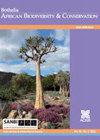南非西开普省外来入侵植物管理志愿者团体的动机和贡献
IF 0.5
4区 生物学
Q4 PLANT SCIENCES
引用次数: 9
摘要
背景:生物入侵的研究和管理传统上侧重于国家运作的大规模控制举措,很少强调志愿者。然而,志愿活动可以有助于发现、根除和遏制外来入侵植物物种。了解志愿者参与外来入侵物种管理的程度很重要。同样,了解志愿者志愿服务的动机对于提高外来入侵物种管理的成功与否也很重要。目的:在本研究中,我们旨在:1)确定在南非西开普省控制IAPS的志愿者团体,2)了解他们在检测和控制IAPS方面的实践和贡献,3)检查志愿者控制IAPS的动机,以及4)确定志愿者个人和团体面临的挑战。方法:采用在线问卷调查的方式收集资料。结果:我们总共确定了52个志愿者团体。我们大致估计,这些团体清理了近8000公顷的土地,根据正式的国家管理成本估算,每年的劳动力成本估计为650万兰特(相当于38万美元)。大多数志愿者组织都自己筹集资金来促进他们的工作,然而,许多人建议政府实体、土地所有者和非政府组织的支持会有所帮助。大多数志愿者(82%)发现并向他们的团队领导、公民科学平台和相关部门报告入侵物种。志愿者自己通过结识新朋友获得身心上的满足,并建立自己的社会资本。结论:我们的发现指出了这些团体的宝贵贡献,但也指出了志愿者团体和科学、政策和管理方面的权威机构之间需要更好的协调和参与。本文章由计算机程序翻译,如有差异,请以英文原文为准。
Motivations and contributions of volunteer groups in the management of invasive alien plants in South Africa’s Western Cape province
Background: Research and management of biological invasions traditionally focuses on state operated large scale control initiatives, with little emphasis on volunteers. Volunteering can, however, contribute to detection, eradication and containment of invasive alien plant species (IAPS). Understanding the extent of involvement of volunteers in invasive alien species management is important. Similarly, understanding volunteers’ motivations to volunteering is important to improve the success of invasive alien species management. Objective: In this study we aimed to: 1) identify volunteer groups controlling IAPS in the Western Cape province of South Africa, 2) understand their practices and contributions towards detecting and controlling IAPS, 3) examine volunteer’s motivations for controlling IAPS, and, 4) identify the challenges individual volunteers and groups face. Methods: The data were collected using online questionnaires. Results: In total, we identified 52 volunteer groups. We broadly estimate that these groups clear nearly 8000 ha of land with estimated labour costs of ZAR 6.5 million annually (equivalent to USD 0.38 million) when aligned with formal state management cost estimates. Most volunteer groups raise their own funds to facilitate their work, however, many suggest support from government entities, landowners and Non-Government Organisations would help. Most volunteers (82%) detect and report invasive species to their team leaders, citizen science platforms and relevant authorities. Volunteers themselves gain physical and psychological fulfilment and build their social capital by meeting new people. Conclusion: Our findings point to the valuable contribution of these groups, but also the need for better co-ordination and engagement between volunteer groups and mandated authorities on science, policy and management.
求助全文
通过发布文献求助,成功后即可免费获取论文全文。
去求助
来源期刊

Bothalia
生物-植物科学
CiteScore
1.70
自引率
0.00%
发文量
12
期刊介绍:
Bothalia: African Biodiversity & Conservation is published by AOSIS for the South African National Biodiversity Institute (SANBI) and aims to disseminate knowledge, information and innovative approaches that promote and enhance the wise use and management of biodiversity in order to sustain the systems and species that support and benefit the people of Africa.
The journal was previously published as Bothalia, and had served the South African botanical community since 1921. However the expanded mandate of SANBI necessitated a broader scope for the journal, and in 2014, the subtitle, African Biodiversity & Conservation was added to reflect this change.
 求助内容:
求助内容: 应助结果提醒方式:
应助结果提醒方式:


